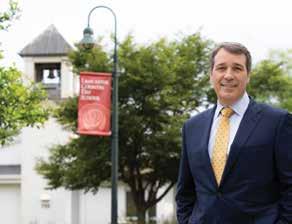NO APOLOGIES FOR WANTING COUNTRY DAY TO BE BETTER
by Michael Schwartz
Sean Mendez-Catlin’s journey took 15 years and brought him full circle. The 2008 grad was a sophomore when a brouhaha over — of all things — an article he wrote for the school newspaper first soured him on LCDS as an institution. Slights and thoughtless, ignorant incidents accrued and strengthened his indifference, bordering on mild antipathy, toward Country Day by the time he left for the University of Pennsylvania. “I decided not to have much to do with the school,” said the lawyer and founder of the new Alumni of Color group. “Until recently.”
“What changed was I heard that they wanted there to be a more friendly environment for minority students, and I felt that the school was genuine, that they were serious about being better, and I wanted to help them with that,” Mendez-Catlin said. Two years ago, after a three-year turn in the Orlando prosecutor’s office, MendezCatlin opened his own firm. He earned his J.D. from the University of Miami and a bachelor’s from Penn, but for our purposes, Mendez-Catlin’s story begins one year after starting at Country Day, when he pitched a story to the teacher overseeing the newspaper and got an enthusiastic thumbs-up. “There was always a disconnect because I was the only Black male and the only Latino male in my class,” Mendez-Catlin explained. “That was rough sometimes, so I had an idea to write an article on race relations at school. Where things started and where they were now, asking minority students how they felt, basically.
“I interviewed many different people and the piece was mostly just their quotes, sharing stories anonymously of what they’d experienced, so they’d feel free to speak candidly,” he continued. “Someone mentioned this poster, ‘Faces of LCDS,’ which consisted entirely of white faces, except for one mixed-race kid who was so light -skinned that they could have easily passed for white.” For this student, the poster embodied the tacit, perhaps unintentional, but nonetheless constant projection of otherness that minority students felt. It didn’t take long for the paper to get into the hands of various administrators, each of whom was just shy of furious at the imputation of racism they perceived in the article. “They asked me to issue a retraction and to apologize,” Mendez-Catlin said. “First off, I wasn’t even the one who said it, but even if I had been, the answer still would have been no. So I left the paper instead.” For all this drama, Mendez-Catlin said that he enjoyed the academic parts of Upper School very much, and that, “There are people I consider family who I met there. I don’t think anything I experienced was specific to race or specific to me. The education is great, and I went through it and never looked back,” he said. An essential part of the Alumni of Color group’s mission is to provide mentoring resources for current students. “Somebody to talk to who’s experienced what they’re experiencing can be exactly the person to lead them through what they’re going through,” Mendez-Catlin said. The work of connecting current students with alumni who may be able to help them better understand or navigate a particular situation is one of the functions of Director of Equity and Inclusion Angela Gordon, whom the school hired in a new, full-time administrative role last summer.
“I want to be a liaison between Sean and Head of School Steve Lisk and the Development Office and the Black Student Union and, basically, any student I can help in any way I can,” Gordon said. Gordon explains the director of equity and inclusion position this way:
“We are one school with one cohesive environment. I want us all to work together to be our best selves,” Gordon said. “We all have unique backgrounds and come from different beginnings, but despite whatever differences we may have, I want us to work together to bring everyone together to improve the school. Part of that is promoting diversity.” The new Alumni of Color group is still in its infancy, but it’s already attracted roughly 40 members and named a seven-member board. Mendez-Catlin said that, besides mentoring, one of the group’s goals is to advise the school on certain questions, of curriculum for example. Here, MendezCatlin stopped to make an important point perfectly clear: “In no way do I think we’re an oversight board,” he said. “We’re a consultant; we’ll provide advice. The school is free to take that advice or not, but we feel that the important thing is for Country Day to be open. As long as the school is open-minded, we can accomplish a lot. I’ve gotten the sense that they’re willing to listen to our suggestions, and if they do, I believe it’ll help more diverse students succeed in more situations.” ALUMNI OF COLOR BOARD MEMBERS Sean Mendez-Catlin, Chair Brandon Watson, Vice-chair Melissa Baez, Secretary Cristian Tineo, Historian Lenaiya Flowers, Community Liaison Sophia Marshall, Treasurer/Head of Activities Ajay Chatha, Parliamentarian
| ISSUE NO. THIRTEEN 2020 |
5







